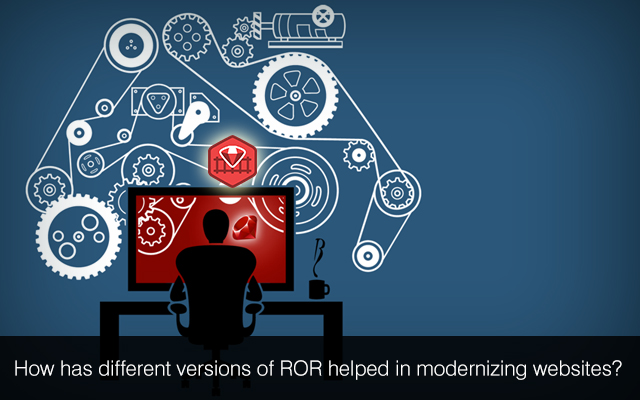Ruby on Rails (ROR) was written in Ruby as a full stack web application development framework. But many reports have highlighted that Ruby now ranks as a hugely popular programming language due to ROR. As a software library, ROR extends Ruby by supporting a number of commonly used software development architectures. It also combines Ruby with other popular web technologies like HTML, CSS and JavaScript to meet the needs of large and complex internet application development projects. Despite being an open source web development framework, ROR is being updated with new features and enhanced capabilities at regular intervals. Each version of ROR also makes it easier for programmers to modernize their web applications.

Technical Highlights of Different Versions of Rails
Early Versions: ROR was developed by David Hansson based on one of his project management tools. Rails 1.0 was released on December 13, 2005. The web application development framework grabbed attention in 2006, after Apple announced that ROR would be bundled together with the Mac OS Xv10.5 Leopard. However, the announcement became a reality only in 2007. After the release of its version 2.3 in 2009, innovative features were being added to ROR. Over a period of time, templates, engines, model forms and Rack web server were integrated into ROR. These features make Rails a simple, easy and user-friendly framework for web development. ROR also enables developers to accomplish several tasks without writing lengthy and complex code.
Support for MVC Architecture: The huge popularity of Rails can also be attributed to its support for model-view-controller (MVC) architecture. The architecture makes it easier for web developers to separate the business logic from presentation. The business logic is stored in the Model, whereas the user interface remains inside the View. Thus, a clear isolation can be maintained between the business logic and presentation. The MVC model makes it easier for enterprises to develop large web applications by deploying distributed teams. At the same time, the feature also helps programmers in marinating and updating the code without putting any extra effort.
Improvement in Rails’ Basic Environment: The basic development environment of ROR also includes WEBrick (web server) and Rake (build system). As Rails depends on a web server to run consistently, the programmers also have option to run it on multiple web servers including Abyss, Apache and Lighttpd. ROR also started using more and more Script.aculo.us for Ajax and JavaScript libraries like Prototype. Rails also switched its web servicing from SOAP to RESTful. The Rails 3.0 even allowed web programmers to use Unobtrusive Java Script. As Rails is a full stack framework, the developers can use it to rapidly create pages, templates and even query functions.
Emphasize on Widely Used Software Development Patterns: Rails was also designed based on some of the widely used software development patterns and paradigms including Don’t Repeat Yourself (DRY) Principle and Convention over Configuration (COC). The DRY principle requires programmers to store the information in a clear and centralized location. The single and clear location of information will make it easier for ROR to derive the required information through database simply by using the class name as the basis. Likewise, the COC required programmers to specify only the non-standardized aspects of the project. By emphasizing on these widely used patterns, ROR makes it easier for developers to standardize the web application development process.
An enterprise can always use the most recent version of ROR to meet the latest trends in internet application development. The latest version of ROR can also be installed as part of the current version of Ruby programming language by using RubyGems. However, ROR also needs to be deployed along with a database server. To get maximum benefits of Ruby development, you may consider hiring services of a ROR development company.
We provide Ruby on Rails development services. If you would like to talk one of our expert Ruby on Rails developers, please get in touch with us at Mindfire Solutions.

/image%2F1058540%2F20140523%2Fob_9762b0_profile-pic.jpg)